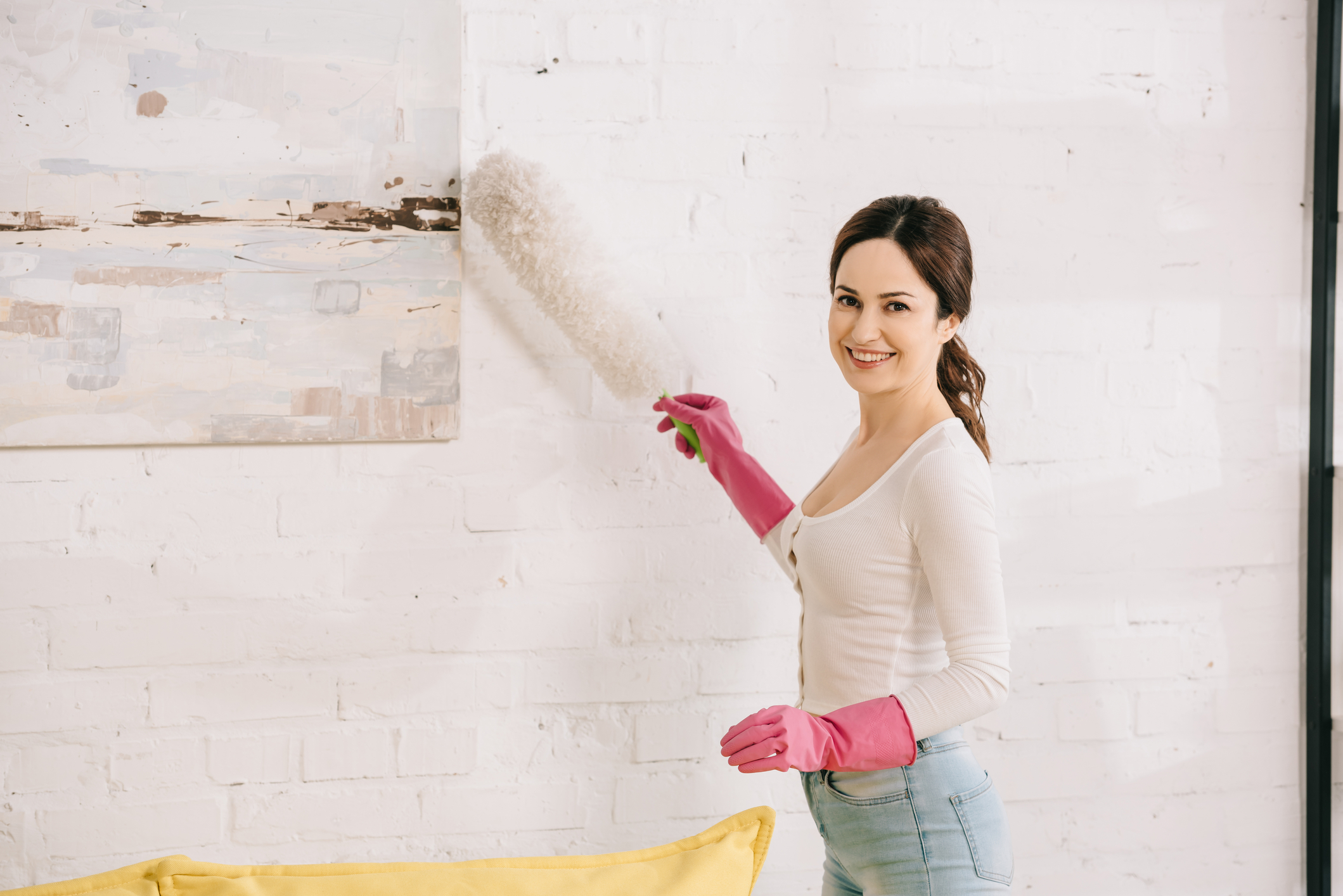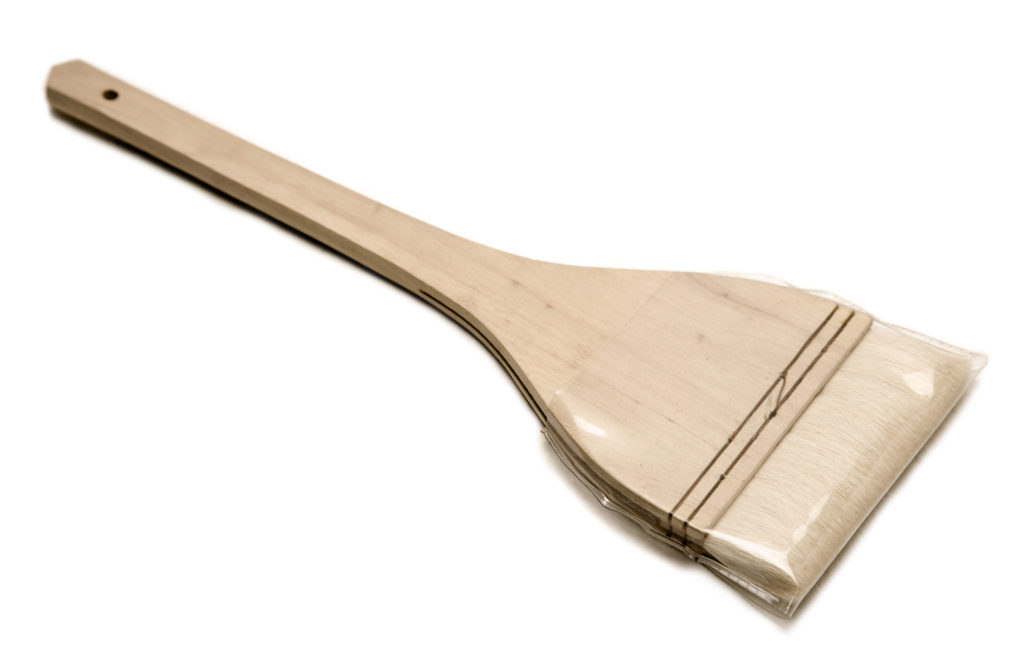You spent hundreds or thousands of dollars in collecting your favorite paintings. You can wipe away all its value with improper cleaning. On the other hand, one of the most important things you can do to protect your art collection is to keep it clean. But, how do you know what cleaning method is best for your painting and what cleaning products you should use? (...or not use).
The best way to clean a painting is to use a soft, unused paint brush to sweep away grime gently. Place an exposed-medium piece on a flat, stable surface in a light other than its regular display lighting. Work downwards in stip paths drawing any debris towards the bottom and off the artwork.
We're here to lend our cleaning experience and research to walk you through the best way to clean paintings and other fine art. There are critical considerations you should keep in mind as you maintain your art collection.

Start With Good Handling & Preventative Measures
Working with a clean surface and tools is vital to achieving the best result.
Clean your workspace and cover it with paper or with a clean sheet. Make sure your workspace is located at your waist level. This will allow you to reach and clean effectively without strain.
Use quality full-spectrum lighting that evenly covers the workspace. Proper artificial lighting will help you locate debris and allow you to remove it.
As you lean over your painting, consider wearing:
- White cotton gloves
- Mouth cover, which covers facial hair
- Hairnet
We recommend against using the following tools:
- Cotton swab
- Cotton ball
- Paper towel
- Sponge
- Damp cloth
Cleaning Your...
Original Oil or Acrylic Paintings
For original oil or acrylic paintings, you should employ an unused, soft, oil paint brush. Lightly brush in strips from top to bottom with your dedicated brush.
Once dry, acrylic paint and oil paint retain the artist's brush strokes leaving a textured surface that can collect airborne contaminants. The goal is to clean these nuanced surfaces without damaging them.
Stay away from these methods when cleaning your oil or acrylic painting:
- Do not use saliva even though some recommend it.
- Food products or chemicals should not be used.
- A consumer compressed air duster is not a good option.
When a brush is not appropriate, you may use a photo lens air bulb to clean any debris off your painting. This bulb cleaner is hand-powered, allowing you to control your cleaning. And you will protect your artwork since it has no chemical propellants.
But if your painting needs more cleaning than just dusting off and blowing debris away, consider turning to a professional. A professional will be able to remove heavy deposits as well as repair any damage to the piece.
Watercolor Paintings
Water paintings are one of the most delicate and fragile wall art mediums.
When cleaning watercolor paintings, you should, of course, avoid moisture.

Use a completely dry brush that has never been used. You can use this brush to sweep away dust moving in horizontal or vertical paths. You may also employ a photo lens air bulb cleaner for more delicate operations.
Some sites recommend using white bread to absorb oils on watercolor paintings that have been handled. The idea is that white bread can help remove fingerprints and even some moisture. But, we do not recommend using bread due to variations in manufacturing, baking, and ingredients or chemicals. Using white bread also can leave behind micro crumbs on the application surface, defeating the purpose of cleaning the painting.
Since watercolor paintings are fragile, do not hesitate to contact a professional restoration service to remove a stain or for deeper cleaning. After your piece is back, we suggest framing it to protect this type of artwork.
Vintage Posters and Prints
You should, as explained before, use a dedicated soft paint brush to dust vintage posters and prints.
Dry and clean cotton or microfiber cloth can also be used for this purpose-dust from top to bottom or side to side stroke patterns. Never sweep or brush in circular patterns. Dust with a light hand and do not scrub.
Your vintage posters or prints should ideally be framed to prevent dust from gathering on the piece.
Again, if your poster or print is significantly damaged, torn, or requires heavy deposit removal, turn to a professional restoration service to help remove stubborn stains.
Limited Edition Prints
The same goes for limited edition prints but with considerable extra care. Make sure that your microfiber or soft cloth is dry and tightly woven. These will be extra gentle when removing dust and debris.
Do not clean in circular or diagonal patterns. Instead, brush or wipe from top to bottom or side to side stroke patterns described in the section above.
Giclee Prints
Giclee prints are photos or reproductions of paintings printed on a variety of surfaces with inkjet. These inks are relatively resilient, and your primary consideration should be not to damage the print surface.
These prints can be cleaned with the same paintbrush method or a clean, dry cloth. Clean in stroke patterns going from top to bottom or side to side.
For heavy cleaning or a damaged surface, contact a restoration service to fix your print. Alternatively, consider having a new giclee produced. Many online services can reproduce a high-quality replacement like CanvasDiscount.
Framed Art
Framing your art is best for long-term preventative care.

When cleaning framed art, first take it off the wall, easel, or other mounting and clean it on the flat work surface we prepared earlier. Attempting to clean framed artwork in place on a vertical and unstable surface can lead to breakage and damage to the frame, glass, or worse yet, the artwork within.
A gentle dusting spray cleaner may be used for this type of cleaning as long as the frame and glass are in good condition and not antique. Do not use cleaning supplies containing:
- Amonia
- Abrasives like baking soda
- Mild detergent surfactants like dish soap or brush soap
- Solvents like paint thinner
Apply the cleaning solution to your cloth and never directly to the frame or glass. Wipe in long strokes with a gentle touch across the frame and glass. Avoid circular motions. Inspect the glass surface from different angles to ensure no debris or residual cleaner remains.
Allow it to dry thoroughly before returning your framed art to display.
How Much Does It Cost to Clean a Painting Professionally?
To have a painting professionally cleaned costs between $100 to several thousand dollars. The price is based on the artwork's medium, size, and type of restoration measures required. Factors like research, labor, and insurance also contribute to the invoice from a quality art restoration service.
But there are ways to save some money when cleaning your artwork professionally. Find a local professional restoration service, so no shipping is required. Save on transportation by taking it there personally.
And before choosing a professional, discuss problems and offer to send high-resolution photos for evaluation and quotation.
Add the cleaning service's invoice to your collected documentation in your provenance file. Professional-level cleaning should be noted as part of the history of the artwork.
Does Insurance Cover Cleaning?
As a general rule, homeowner's insurance covers artwork undergoing cleaning at home. Contact your insurance company to confirm coverage under your contract. Art restoration companies carry their own insurance. A homeowner's policy will not apply to an art piece at a professional's location.
Check with cleaning professionals about their insurance coverage while the art piece is in their care. Always ask for receipts or contracts when deciding to employ a restoration service. Keep all your original documentation secured, providing copies to the restoration company if requested.